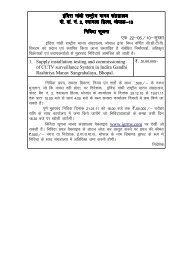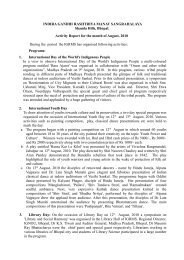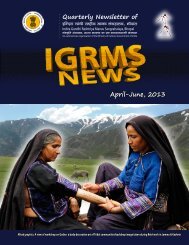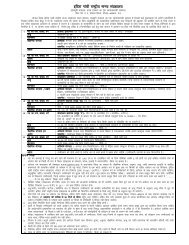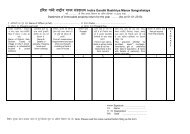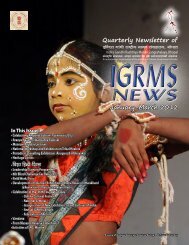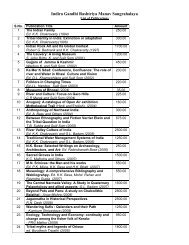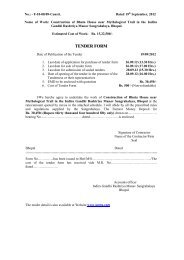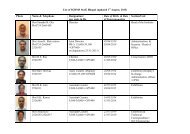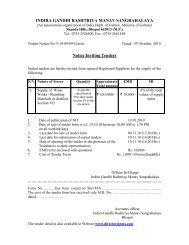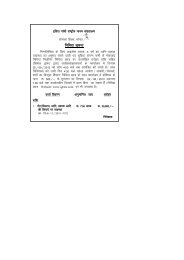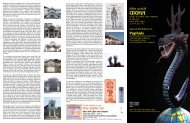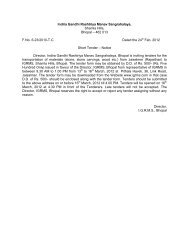Indira Gandhi Rashtriya Manav Sangrahalaya (National ... - IGRMS
Indira Gandhi Rashtriya Manav Sangrahalaya (National ... - IGRMS
Indira Gandhi Rashtriya Manav Sangrahalaya (National ... - IGRMS
You also want an ePaper? Increase the reach of your titles
YUMPU automatically turns print PDFs into web optimized ePapers that Google loves.
280 Multiple Heritage: Role of Specialised Museums in India<br />
up after the <strong>IGRMS</strong> began establishing. These include the renowned Bharat Bhawan<br />
Multi-art complex, All India Radio and Doordarshan, the State Museum of Madhya<br />
Pradesh, a Tribal Museum, Regional Museum of the <strong>National</strong> Council of Science<br />
Museum and a large number of other educational institutions managed by several<br />
NGOs.<br />
Museum Infrastructure<br />
Development of infrastructure for the new Museum was a major challenge. It<br />
required heavy financial investments and manpower, dedicated scholars and<br />
visionaries who could interpret the cultural bonds of the country. An Advisory<br />
Committee set up in 1981, recommended that the Institution should be converted<br />
into an Autonomous Body, to be managed by a group of subject experts from<br />
different disciplines and representative officials of different ministerial<br />
organizations. The recommendations were accepted by the Cabinet Secretariat<br />
of Government of India and the Autonomous Society named ‘<strong>Rashtriya</strong> <strong>Manav</strong><br />
<strong>Sangrahalaya</strong> Samiti’ was registered under Registration of Societies Act, 1860, in<br />
March, 1985, with the following major objectives to:<br />
(a) Present, through exhibitions and educational programmes, an integrated<br />
story of bio-cultural evolution of man with special reference to India,<br />
highlighting the richness and diversity of its cultural patterns and the<br />
underlying unity;<br />
(b) Promote national integration;<br />
(c) Take steps to salvage and preserve the fast vanishing aspects of Indian<br />
culture;<br />
(d) Act as a centre of research and training in museology of appropriate<br />
kind and generate a new museum movement in different regions of India<br />
to present and preserve variety of cultural life.<br />
Individual experts from the fields of anthropology, archaeology, museology,<br />
folk art etc. were nominated to the governing councils of the Museum for specified<br />
durations, and representative officials of the central government in the ministries<br />
of Culture, Home Affairs, Tribal Development, Environment, as also from the<br />
State Government of Madhya Pradesh were inducted. The main source of funding<br />
for infrastructure development and education activities were to come from the<br />
central Ministry of Culture, and the Minister-in-Charge of the Ministry of Culture<br />
designated as the President (ex-officio) of the Governing Samiti. The Secretary<br />
to the Ministry of Culture, GOI would act as ex-officio Chairman of its Executive<br />
Council.<br />
When the Site was occupied for infrastructure development, the landscape<br />
was barren, rocky and devoid of any vegetation. There was no water sources in<br />
the campus, nor any link road to approach the public ways outside. The campus<br />
was to be landscaped within these constraints. Development of Infrastructure




